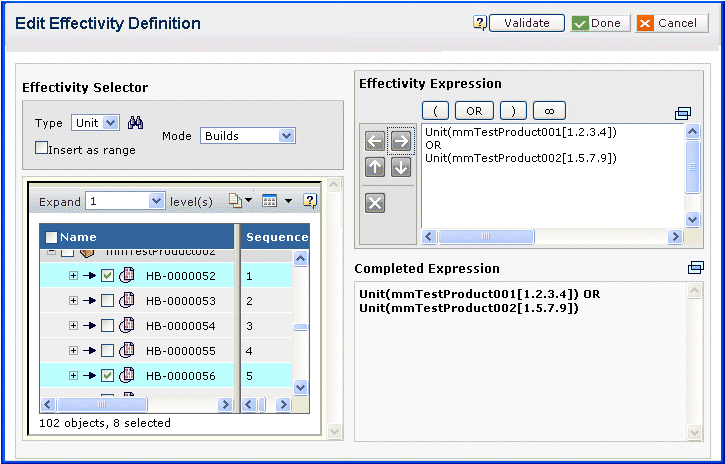Effectivity Definition Dialog Box | ||
| ||
Example Dialog Box
This screens shows an example of the Edit Effectivity Definition dialog box as defined by the EffectivityDefinitionDialog.jsp. This guide describes how this dialog box is defined; see the Configuration and Effectivity Services User's Guide for details on how a person uses this dialog box to build effectivity expressions.

![]()
URL Parameters To Pass to the Dialog
This JSP is used by Configuration and Effectivity Services, and should only be called by a custom application if a custom JSP is needed. This table lists the parameters that must be passed to the Effectivity Definition dialog box:
| URL Parameter | Description | Accepted Values/Examples |
|---|---|---|
| fieldNameActual | The field in the structure browser used to display the actual effectivity expression. Used only when invockedFrom=fromTable. | Valid structure browser field name. |
| fieldNameDisplay | The field in the structure browser used to display the display effectivity expression. Used only when invockedFrom=fromTable. | Valid structure browser field name. |
| fieldNameEffExprActual | The field that displays the actual effectivity expression. Used only when invockedFrom=fromForm. | Valid field name. |
| fieldNameEffExprActualList | The field that stores the actual expression list when re-editing an expression. Used only when invockedFrom=fromForm. | Valid field name. |
| fieldNameEffExprActualListAc | The field that stores the actual expression list when re-editing an expression. Used only when invockedFrom=fromForm. | Valid field name. |
| fieldNameEffExprDisplay | The field that displays the effectivity expression. Used only when invockedFrom=fromForm. | Valid field name. |
| fieldNameEffExprOID | The field that stores the binary filter expression. Used only when modetype=filter and invockedFrom=fromForm. Required if modetype=filter | Valid field name. |
| fieldNameEffTypes | The field on the above form that holds the check boxes to define the type of effectivity allowed for the context object. Used only when invockedFrom=fromForm. | Valid field name. |
| formName | The form where the effectivity expression should be populated. Used only when invockedFrom=fromForm. | Valid form name. |
| invockedFrom | Required. Defines the type of object that invoked the dialog box. |
|
| modetype | Required. Defines the type of dialog used when the dialog is invoked. |
|
| objectId | Only required when modetype=edit. Provides the objectId of the object for which the expression is being edited. | Valid objectId. |
| postProcessCFFURL | Defines a JSP page to call when the dialog box is dismissed. See Post Process URL for an Editable Form Page in the Business Process Services Administrator's Guide for details. If the user cancels from the invoked page, the user is returned to the Effectivity Expression Definition; if the invoked page is submitted successfully, the Effectivity Expresion Definition dialog continues with the submit process. | ..\engineering\emxVerifyModStack.jsp |
| showAnd | Shows or hides the AND button for use in building the effectivity expression. If there is a single effectivity type, AND does not make sense, and if used, creates an invalid expression. Hiding the button in this use case prevents this problem. True shows the button. If this parameter is set for the dialog box JSP and the command (see Type Menu and Mode Menu), then the command's value overides the JSP value. |
true (default) false |
| showContext | If true, pre-populates the tale used by the Effectivity Selector with the context objects defined by the current Effectivy Expression. This parameter has no effect if format=date for the command in the type menu. | true false (default) |
| showOr | Shows or hides the OR button for use in building the effectivity expression. True shows the button. If this parameter is set for the dialog box JSP and the command (see Type Menu and Mode Menu), thenthe command's value overides the JSP value. | true (default) false |
![]()
Effectivity Expression
The dialog box includes tools to help the user build the effectivity expression. See the Configuration and Effectivity Services User's Guide for details. Although the user can define the expression by selecting data and clicking buttons, the user can also directly enter an expression. When the user clicks Validate, Configuration and Effectivity Services validates the syntax of the expression only; it does not validate that any specified objects in the expression exist. For example when entering Builds, 1-100 is a valid range even if the highest build number is only 50.